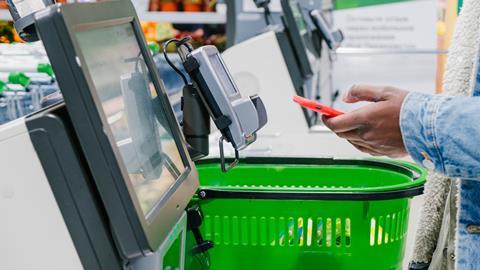In stark contrast to Booths ditching self-service checkouts (SSCs) from its supermarkets earlier this month, Tesco last week revealed it is trialling new tech at its Fulham Reach Express GetGo store. The trial means customers can take items from shelves and “just walk up” to the checkout, which will “magically present them with a list of the products they have picked up”.
Both are bold bets on the future of supermarket service. So which strategy makes most sense?
Booths’ decision is an unusual one, and goes against the trend of SSCs becoming more ubiquitous in stores of all sorts and sizes.
“We’re not great fans of self-checkouts,” Booths MD Nigel Murray told The Grocer. “We pride ourselves on great customer service and you can’t do that through a robot.”
His comments will certainly resonate with a large segment of customers who feel grocery shopping is getting more and more impersonal. Like 69-year-old Pat McCarthy, whose petition against Tesco’s increased use of “self-service and sort-it-out-yourself card-only till machines”, which has gathered close to a quarter of a million signatures.
More managed checkouts require additional staff
The Booths move is based on customer feedback, and “what we feel is the right thing to do”, suggesting more than a hint of customer service virtue signalling.
Which might land with the affluent, older demographic Booths is targeting. But did the supermarket ask those who happily breeze through SSCs and don’t have time in their day to write letters of complaint?
It is, however, worth noting Booths isn’t ditching self-service checkouts completely. It “made sense” Murray said, to keep them operating at two of the supermarket’s busiest stores in the Lake District – in Windermere and Keswick. Let’s hope none of the other stores experience a peak period.
And it will come at a cost. More manned checkouts require more staff. Booth’s complaints about SSCs include customers having to wait for a store colleague to visually ID them when buying alcohol, which suggest it wasn’t assigning enough staff to them to begin with.
Though, this isn’t an issue exclusive to Booths. When asked to choose a single intervention to improve SSCs, 37% of store worker respondents to a ECR Retail research survey answered more staff on the machines – more than double the proportion that said “better designed machines”.
Amazon Fresh has responded to lacklustre footfall
Besides, Booths’ latest accounts show a sales and profits fall, in part as a result of wage inflation.
At the opposite end of the spectrum, customers are hardly bowled over by fully autonomous stores either. Amazon has had to shutter several Fresh stores, which haven’t exactly been flooded by customers. And for now the initial capex on fully autonomous store tech is huge – meaning it takes years to recoup any savings on staffing costs.
Undoubtedly, there’s demographics at play. Those shopping at the ‘Waitrose of the north’ and expecting a chinwag – some stores even feature a bell customers can ring for attention – are not the same people as the central London city slickers or students wanting to grab a sandwich in as little time and with as little human interaction as possible at a Tesco GetGo.
But while the checkout-free stores like GetGo, Sainsbury’s Smartshop Pick & Go, or Amazon Fresh have responded to lacklustre footfall by working to make stores more appealing to a wider customer base – many adding app-free payment options and manned checkouts since launching – Booths seems to be shutting out those who might prefer SSCs.
Truly exceptional customer service is about providing shoppers with choice, and that includes the checkout. Rather than make sure the service level is there whichever method customers do choose, Booths appears to be simply taking options away.

























No comments yet